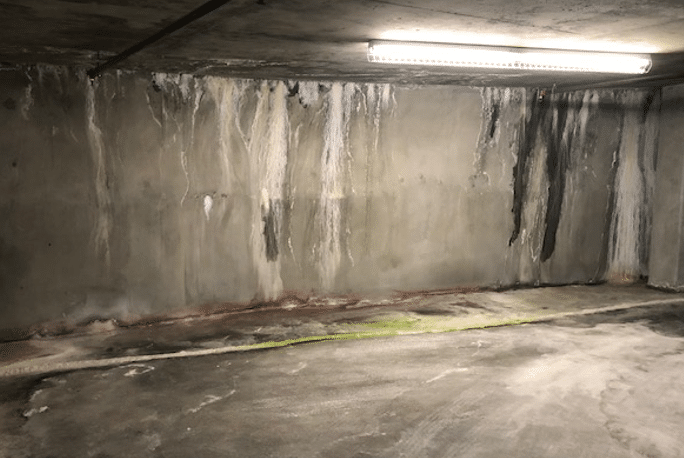Many multifamily and commercial/office buildings in urban areas contain underground parking garages. These garages can extend anywhere from one level to multiple levels below grade. While the portion of the building above ground needs to be weatherproof, the walls below grade need to be made waterproof. Simply put, the basement of a building is analogous to the hull of a boat; water within the ground is pushing against the foundation walls and only impeccable waterproofing will resist infiltration when exposed to this water pressure (referred to as “hydrostatic pressure”).
When is Water Leakage a Concern?
It is not uncommon for flaws in the waterproofing to lead to visible leaks within the basement of a building. The leaks can vary from a small discoloration on the surface of the garage walls to considerable amounts of water penetrating the walls. Minor discoloration of walls from moisture is typically not the cause of concern for our clients. Often, we become involved when more discernable amounts of water enter cracks through the foundation walls or floor slabs and, in some cases, enter the garage in such a quantity that occupants have to walk through standing water when going to/from their cars. These leaks can range from merely being unsightly to a nuisance for occupants, to causing damages by dripping on vehicles and creating potential slipping hazards. Leaks in the garage can also raise questions about the potential structural impact of the moisture within the wall itself.
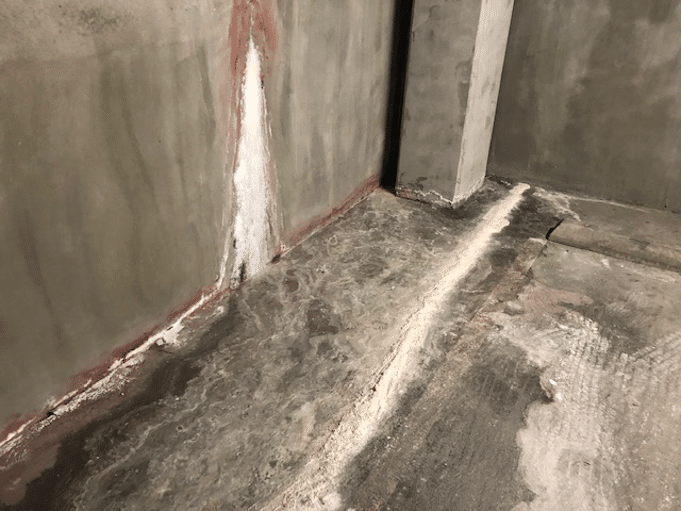
VERTEX is frequently asked by building owners and property managers to assess these leaks and provide a scope of repair to address them. This article discusses typical waterproofing assemblies, how leaks occur, and methodologies for assessing and repairing them.
The Concealed Waterproofing Assembly
The waterproofing must be designed and installed with the utmost quality to keep water from penetrating the garage walls and floors. In a nutshell, during the original construction of a project with a below-grade parking garage, the site is excavated to the proper depth, shoring is installed at the perimeter of the excavation to keep the surrounding soil in place, and waterproofing is installed prior to the placement of the concrete garage walls. After the waterproofing is installed, the concrete foundation walls are placed against the waterproofing, which sandwiches the waterproofing between concrete and the shoring/soil thus leaving the waterproofing inaccessible.
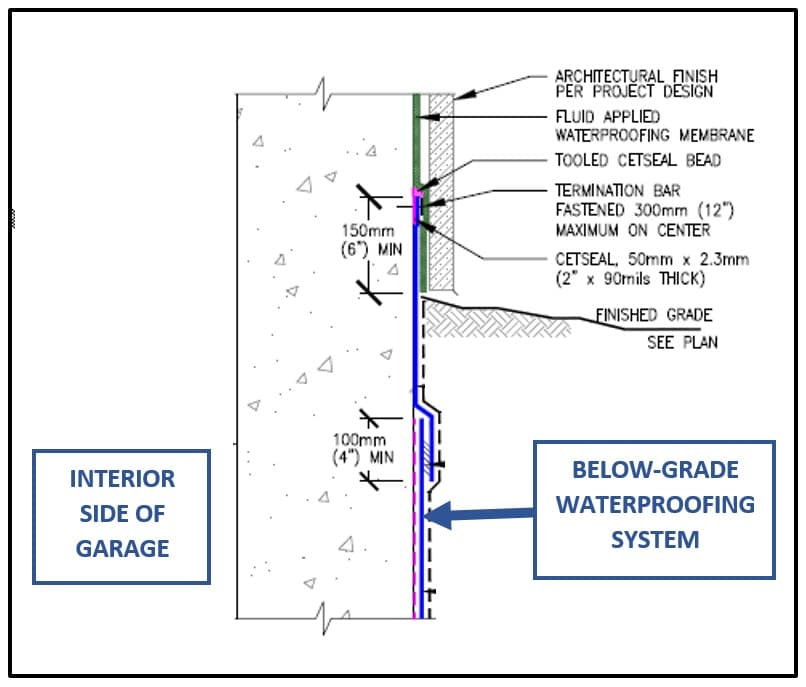
Based on this description and illustration above, you can imagine that correcting any flaws in the waterproofing material is challenging. If the garage is one level below grade, perhaps excavating the soil at a particular side of a building can be considered, but if the garage extends multiple levels below grade, the typical repair method involves addressing the leaks from the interior of the garage rather than finding and correcting the actual breach in the waterproofing material.
Water Leakage Investigation
If water is seen on the walls of the subterranean garage, what steps are taken by a building owner or property manager to address them? The first step is for a building owner or property manager to get in contact with a forensic waterproofing consulting firm with architects, engineers, and construction professionals who are well versed in investigating waterproofing issues. The forensic consulting firm will determine the makeup of the concealed waterproofing assembly, assess the location(s), extent, and frequency of water leakage, and then prescribe repairs to be implemented by a specialized waterproofing contractor.
If the building plans and specifications are available, this documentation is valuable in determining the type of waterproofing used. However, construction documents are not always available for review, and in these cases, the consultant will verify the waterproofing assembly used by alternate means, such as direct examination.
To assess the water leakage, the consulting professional will accurately document locations where water is manifesting at the interior of the garage. The investigation of wall leakage includes visually examining and photographing the wall and floor surfaces as well as the use of various forensic tools such as infrared thermography and moisture meters. The documentation of findings should occur in a very methodical way. The perimeter walls of the garage should be identified as short wall segments and detailed moisture mapping should document all potential areas of infiltration within each segment. This method of documenting the leak locations serves as an excellent way to quantify and label areas of leakage and ultimately provides a waterproofing repair contractor with a detailed scope of work that they can use to generate a cost proposal.
Determining the Water Source
In addition to examining the walls and floors for moisture, a thorough assessment of the conditions surrounding the building should occur, so as to identify potential sources of water that can be corrected (i.e. roof leaders draining water to grade), back pitched grade resulting in water ponding adjacent to the foundation, and any breaches in the waterproofing where the upper termination of the waterproofing interfaces with the above-grade exterior walls.
When water within the surrounding soil makes its way past the waterproofing membrane and reaches the backside of the garage walls, the water then travels until it ultimately finds a pathway into the garage. As such, the location where the water manifests within the garage is not necessarily the point in which it bypassed the waterproofing assembly. Oftentimes, the water will appear in the garage at cracks in the concrete, at grouted tie-back penetrations, and/or where the concrete deck interfaces the concrete walls (i.e. at cold joints in the concrete). The assessment of such leakage should occur when the water in the surrounding soil is at its greatest (such as after heavy rain events and/or generally in the “rainy season” for the particular region) in order to witness the maximum extent of the water leakage. The assessment also best occurs over a period of time to track fluctuations in moisture levels at the areas of leakage.
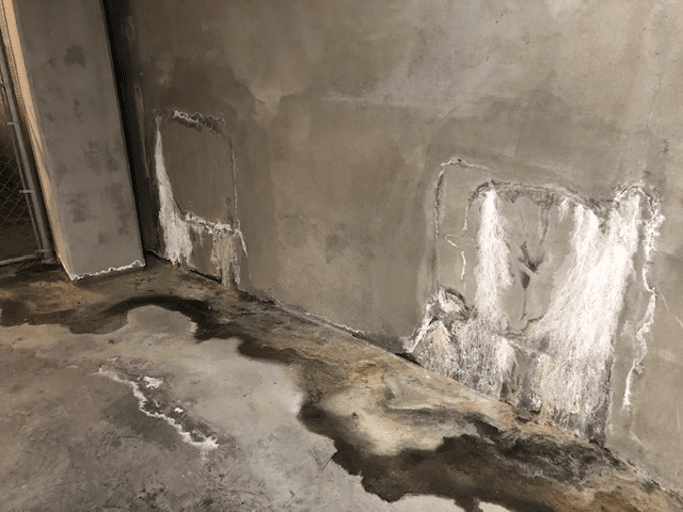
When assessing the water leakage, moisture entering the garage can manifest as liquid water, discoloration on the surface of the garage wall, and/or as efflorescence (i.e. white powdery deposits that are actually soluble salts left behind on the surface of the concrete through evaporation of moisture). If water leaks at the garage walls have been present for a considerable amount of time, the moisture can begin to corrode reinforcing steel within the concrete. This typically results in rust-colored staining visible on the garage wall, and can eventually result in isolated areas of concrete flaking or spalling. Again, these conditions are typically only associated with more advanced stages of water leakage. Frequently the recommended action is to investigate and remedy leakage prior to any structural-related damage occurring at the walls.
Typical Repair Methods for Garage Moisture
As mentioned above, the deficiencies in the waterproofing that created the moisture will likely not be addressed from the exterior side without considerable (and disruptive) excavation efforts, which oftentimes are cost-prohibitive. Depending upon the forensic investigation findings, the waterproofing consultant will develop a repair protocol specific to the areas of leakage documented. Such repairs can include (but are not limited to) any combination of the following negative-side waterproofing techniques (waterproofing applied to the inside face of the walls):
- If staining or efflorescence is present on the garage walls of a project that was recently constructed and no actual moisture appears to be present, this staining may have occurred during the course of construction and not be associated with active (post-construction) water leaks. Water leaks in a subterranean garage can occur during construction before the above-grade building walls are tied into the upper termination of the below-grade waterproofing. In these cases, water infiltration that occurred during construction typically ceases once the above-grade envelope and final grading around the garage have been completed. In these cases, the repair in the garage will simply involve professional cleaning of the water staining/efflorescence from walls. However, it should be noted that if these stains reoccur in the future during extended rainy periods, there may be actual leaks.
- If very minor amounts of moisture are found at the garage walls (i.e. enough moisture to discolor the wall but not enough moisture to make its way to the garage floor), there are multiple ways of addressing the moisture. Minor moisture visible on the surface of the garage walls often only creates an aesthetic issue. To address this type of condition, applying a water inhibiting product to the overall wall surface is one approach. One option is to use a crystalline waterproofing material, which is available as a standalone waterproofing product or an admixture, which can have the appearance of applying a coat of plaster (typically referred to as a “parge” coat of plaster) to the wall surface. This type of waterproofing forms a dense network of microscopic-sized crystals that develops into a robust but breathable moisture barrier. There are advantages and disadvantages to this type of product, as with any product, and all variables will need to be considered prior to prescribing the appropriate material or waterproofing product. Note that it is important not to use certain types of paint products to mask the moisture, which can ultimately retain moisture, bubble and create larger aesthetic problems than were initially present.
- When significant leaks emanate through cracks in the garage walls (or floors), the typical repair will involve crack injection methods, which occurs from within the garage. This type of repair performed by specialized contractors involves drilling small diameter holes in the concrete wall and inserting injection “ports” into the concrete. Epoxy or urethane material is then injected into the ports to fill voids in the wall, whereby sealing pathways for water infiltration. Ports can be positioned in a variety of ways: they can be installed along a particular crack or joint that is allowing the passage of moisture or can be installed in a grid pattern across the wall for an overall injection approach. Keep in mind that this method is not correcting the actual deficiencies that allowed groundwater to reach the backside of the garage wall. The repair is merely ceasing the migration of water through the wall. As one can imagine, injecting in the areas where the water is manifesting can result in the water behind the wall traveling laterally and finding another way to enter the garage (i.e. through another crack, cold joint, tie back, etc.). While this repair method is considered an effective way to halt the infiltration of water through the wall, it can also require an effective repair program to include multiple injection events to completely seal the wall segment from all visible moisture.
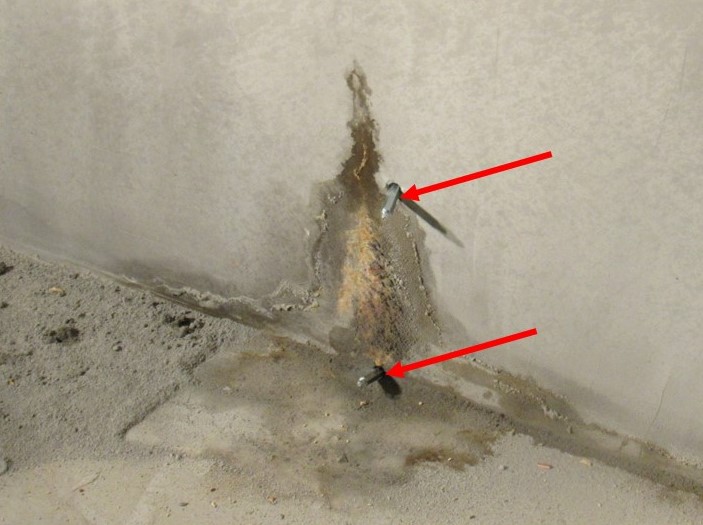
When to Address Moisture Issues
If very minor areas of moisture are present on the walls of a subterranean garage, the cost to eradicate the problem may not be worth the benefit in the end. However, if the extent of moisture is creating unsightly levels of staining and efflorescence, and/or the water is flowing across the garage floor creating slipping hazards for users of the building (or worse, resulting in damage to the concrete wall), then the building owner or property manager should retain a forensic waterproofing consultant to assess the problem and recommend potential solutions. The proper repair of such moisture infiltration begins with the proper investigation, as the proper investigation identifies the full extent of the issue so that an efficient, cost-effective scope of repair can be implemented.
To learn more about VERTEX’s Forensic Consulting services or to speak with a Construction Expert, call 888.298.5162 or submit an inquiry.



